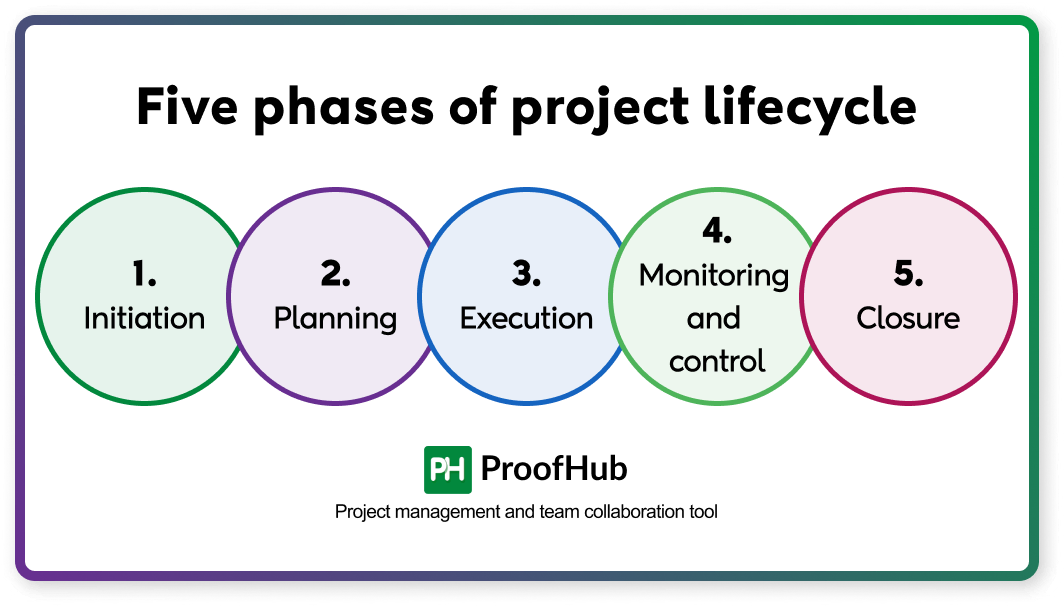Every project has a beginning, a middle, and an end. From start to finish, a project goes through certain phases. Each phase has unique characteristics & activities and produces a certain set of deliverables. The knowledge of those phases, activities, and unique set of deliverables (key documents or artifacts) is compiled in the project management lifecycle (PMLC).
Understanding the project management lifecycle isn’t just helpful, it’s essential for beginner project managers. It guides your project journey. Without it, you’re at the risk of wandering.
This chapter is focused on explaining the concept of project lifecycle management. It is a foundational concept of project management that applies to every project and helps you structure your project.
What is the project management lifecycle?
A project management lifecycle is a standard framework to structure a project from start to finish. It includes five phases: initiation, planning, execution, monitoring & control, and closure.
When you are assigned a project, there are ‘n’ number of tasks you need to juggle: identify requirements, define the scope of the project, outline the acceptance criteria, create a project schedule, plan resources, coordinate with stakeholders, manage the project team, etc.
To easily sail through the process, project management experts across the globe created a standard roadmap to take a project from start to finish, ensuring nothing is overlooked along the way.
According to the Project Management Institute’s (PMI) Pulse of the Profession® 2018 report, 93% of organizations report using standardized project management practices. Out of which, 70% of organizations report higher project success rates.
The reasoning behind this standard framework of project management lifecycle was that irrespective of the project’s nature, complexity, methodology, and size, every project goes through certain phases from start to finish.
Five phases in project lifecycle management
You can create as many steps in a project lifecycle but they eventually fall under these five project phases: initiation, planning, execution, monitoring and control, and closure.

Let’s explore the phases of the project lifecycle.
1. Initiation
Initiation is the first phase of the project management lifecycle and the starting point for all projects. This is the phase where the focus is on gathering the project requirements and ensuring stakeholder buy-in. Based on the established understanding of the project and the agreement received from all the stakeholders on the outlined scope, a project plan is created for the project’s success.
Project initiation phase includes the following key activities:
- Identifying a business need, problem, or opportunity project will address.
- Conducting a feasibility study to determine the project’s profitability with a cost-benefit analysis.
- Identifying all the stakeholders of the project to learn about their expectations and vested interests in the project.
- Defining the project’s objectives, purpose, goals, and requirements to document the project scope.
This results in the creation of the following five key documents:
- Project proposal: Explains why the project is needed, what it aims to achieve, and how it will be executed.
- Business case: Justifies the benefits, costs, and potential risks associated with the project based on the findings of feasibility studies.
- Stakeholder register: Lists all stakeholders and their roles, expectations, & influence.
- Initial risk register: Defines potential risks at the outset and their likelihood and impact.
- Project charter or master document: Outlines the project purpose, objectives, scope, stakeholders, constraints, & high-level requirements, authorizes the project, and assigns the project manager. Once the project charter is approved, a project kick-off meeting is scheduled.
Note:
A project kick-off meeting brings together key stakeholders, team members, and the project manager to align on the project agenda. It is a crucial event that marks the official start of a project, typically occurring after the initiation stage or before the planning stage.
2. Planning
The planning phase is the most crucial phase of the project management lifecycle that defines the roadmap for the project. It includes creating a comprehensive plan for the project that counters every aspect of the project that needs to be managed— tasks, costs, schedule, milestones, quality, deliverables, risks, and more.
The purpose of this phase of project management is to make sure the project’s scope is outlined comprehensively, resources are secured for the project work, and risk mitigation measures are planned to ensure the project’s success. It is one of the most important project management stages.
Project planning phase includes the following key activities:
- Defining the detailed scope of the project by breaking a project into small chunks with well-defined phases, tasks, and milestones.
- Estimating the resource requirements for each task and creating a project plan.
- Planning for various risks in a project.
This leads to the creation of the following set of artifacts:
- Project scope statement: It translates the stakeholder project requirements into a detailed scope of the project.
- Work breakdown structure (WBS): This is the most important artifact of the project planning phase, which provides the hierarchical decomposition of project deliverables into smaller and manageable deliverables.
- Project management plan: It is a comprehensive document that defines all project components and outlines how the project will be executed, monitored, and closed. Key project components include scope, schedule, cost, quality, risk, communication, and resources. The project management plan includes an individual plan for each component:
- Scope management plan: It defines how the project scope will be defined, validated, and controlled. It ensures all necessary work and nothing beyond is included to prevent scope creep.
- Quality management plan: It specifies quality standards, metrics, and assurance processes.
- Project schedule: It defines a timeline with milestones, task dependencies, and deadlines.
- Budget plan: It estimates costs for resources, tasks, and contingency reserves.
- Risk management plan: It defines a strategy for identifying, analyzing, and mitigating risks.
- Communication plan: It outlines how information will be shared among all the stakeholders of a project, including methods and guidelines.
- Resource management plan: It defines how human, physical, and financial resources will be identified, acquired, managed, and released throughout the project lifecycle.
Note:
A project management plan is a dynamic document that evolves as the project progresses. Planning is not static. As more information becomes available, project managers revisit and refine the plan, ensuring it reflects the project’s growing needs. It is for good!
3. Execution
Execution is the third phase of the project where work finally begins on the project. Everything outlined in the project management plan is actually implemented in this stage.
This is a point where a project manager needs to manage a project team. The manager has to assign tasks, coordinate with the team, clarify roles, arrange resources, and deal with day-to-day challenges.
The purpose of this phase is to ensure everything outlined in the project management plan is executed properly so that there are minimum deviations.
Project execution phase includes:
- Assigning tasks to the team members and providing clear instructions.
- Allocating resources efficiently.
- Facilitating clear and timely exchange of information and collaboration with the team to resolve issues as they arise.
This leads to the creation of the following set of artifacts:
- Status reports: Regular updates on project progress, risks, and issues.
- Updated risk register: Continuously updated with new risks, their impact, and mitigation actions.
- Change requests: Formal documents for requesting scope, schedule, or cost changes.
Note:
To be honest, this is the most challenging phase for any project manager. You learn most about real-world project management in this phase. Your team has to perform the project work. Thus, you need to have strong soft skills to get the work done appropriately.
4. Monitoring and control
Monitoring and control is the phase that ensures your project doesn’t veer off course. In this stage, you’ll track the project’s performance closely and make adjustments as needed to ensure it stays aligned with the goals.
Project monitoring and control phase includes the following key activities:
- Regularly gathering data, tracking progress, and analyzing project reports to measure against planned goals.
- Identifying deviations from the planned roadmap and making adjustments to keep the project on course.
- Ensuring stakeholders remain informed about progress, changes, and any potential impacts on project outcomes.
This leads to the creation of the following artifacts:
- Performance reports: Compare actual performance against baselines for scope, schedule, and cost.
- Quality control reports: Documents the results of quality inspections and any defects identified.
- Change log: Keeps a record of all changes made to the project, their reasons, and approvals.
Note:
Quality control is implemented at this stage of the project. It is going to be a tough task for the project manager as most projects derail during this stage. You need to adopt a proactive approach to monitor and control quality.
5. Closure
Project closure is the last stage of the project management lifecycle that formalizes the project completion and documents lessons learned. In this phase, a project manager evaluates the project’s performance.
Project closure phase includes the following key activities:
- Securing approvals and formal acceptance of deliverables by stakeholders or clients.
- Documenting lessons learned from the project for future reference.
- Communicating project closure to stakeholders.
This results in the creation of the following key artifacts:
- Final deliverables: Complete and approved outputs handed over to the client or stakeholders.
- Final sign-off document: Formal acceptance of deliverables by stakeholders or clients.
- Final project report: Summarizes project objectives, performance, achievements, and any deviations.
- Lessons learned document: Highlights successes, challenges, and improvement opportunities for future projects.
- Project archive: Includes a compilation of all project documentation for future reference.
Note:
Project closure signifies the end of the project’s execution. But in reality, a project transitions into the operational phase. The project is handed over for ongoing support and maintenance.
Following these five steps in project management, you can organize project activities to manage a project easily and effectively.
Disclaimer: A project is managed using project management methodology. There are various types of project management methodologies such as Waterfall, Agile, and Scrumfall (which we covered in detail in Chapter 4). Based on the chosen methodology, project activities and artifacts of each phase change. However, the project lifecycle remains the same. For ease of understanding, we have explained the five phases of project lifecycle management and the activities and artifacts of each phase considering the Waterfall methodology for project management.
Why project lifecycle management is important
The project management lifecycle provides a clear roadmap to manage a project from start to finish. It plays a key role in managing a project by helping a project manager:
- Defines what to do at each step of the project.
- Break a project into easily manageable, small phases.
This leads to the following benefits of project lifecycle management:
1. Increase project success
Knowledge and guidance about each phase of the project, the activities included in it, and its outcomes make it easy for a project manager to implement the activities needed to complete a project from start to finish. It results in increased project success because every aspect of the project is taken care of.
2. Make it easy to manage project work
Breaking a project into smaller phases makes it easy for a project manager to manage the project. A project manager can better implement the project activities, utilize the resources, and focus on the phase of the project at hand. The phases make the process straightforward for the project manager and project team.
3. Enhance planning and organization
Setting realistic goals, identifying risks, allocating resources, and creating schedules ensures thorough planning, which reduces the likelihood of project delays, budget overruns, and scope creep.
4. Foster communication and collaboration
Artifacts created throughout the project foster communication by establishing a common language that all stakeholders can comprehend. This enables better coordination and reduces misunderstandings.
5. Better ability to manage project risk
Creating a detailed plan for the project risks early in the project and monitoring them throughout the project lifecycle enables project teams to anticipate, analyze, and mitigate risks before they escalate. Any deviations from the plan are identified early, enabling corrective actions to keep the project on track.
In addition to that, project phases are critical juncture points for a project manager to track project performance and decide whether the project should be amended, terminated, or proceed as planned. Thus, the importance of the project lifecycle lies in helping project managers make crucial decisions.
Challenges in project life cycle management
There are challenges associated with every phase of the project management lifecycle. Here are some common project lifecycle challenges you might face:
- Incomplete or unclear requirements: Not being able to comprehensively gather stakeholder requirements leads to unclear objectives and poorly defined scope. This eventually results in misalignment or ambiguity in the project’s goals and scope creep.
- Unrealistic schedules or budgets: Most managers are guilty of planning fallacy. This leads to overoptimistic estimations that can lead to impractical timelines or cost constraints. It results in poor project plan and failure to follow the project plan.
- Scope creep: Unauthorized changes, evolving expectations, external influences, or poorly managed changes lead to scope creep that can derail timelines and budgets.
- Difficulty in tracking progress and KPIs: Poor tracking of tasks and milestones effectively in real-time makes it hard to catch issues early and adjust accordingly.
- Communication gaps: Poor communication among project team members, stakeholders, or vendors can lead to misunderstandings and delays. This miscommunication or lack of collaboration leads to confusion, missed deadlines, and inefficiencies. In addition, managing diverse personalities, skills, and potential conflicts within the team can be challenging.
- Risk management: New risks emerging during the project can be overlooked or poorly managed. Without a comprehensive risk management plan, unexpected problems can delay progress or increase costs.
- Incomplete deliverables: Ensuring all project deliverables meet the agreed-upon quality and are completed.
Best practices for project life cycle management
By addressing project management difficulties and lifecycle hurdles, you can prevent them from derailing your project’s success.
You can follow these simple practices to manage your projects more effectively:
- Engage with stakeholders: Identify all key stakeholders and engage with them in workshops or interviews to capture detailed requirements. Document requirements clearly and validate them with stakeholders. Involve them in the early stages to align expectations.
- Use the SMART framework to define objectives and goals: Define clear objectives and scope using the SMART (Specific, Measurable, Achievable, Relevant, Time-bound) framework. Create a detailed project charter, outlining scope, objectives, and constraints; and get it validated by stakeholders.
- Create a realistic schedule or budget: Use project planning techniques to develop realistic plans such as work breakdown structure (WBS), historical data, expert judgment, and three-point estimates. Make use of project management software to create a detailed breakdown of tasks.
- Monitor progress regularly: Use KPIs (Key Performance Indicators) and dashboards to measure progress. Keep track of milestones and compare them against your baseline to make timely adjustments.
- Prevent scope creep: Implement a change control process requiring formal approvals for any scope changes. Monitor for signs of scope creep, track interdependencies, and continuously reassess risks. Enforce the agreed-upon change control process.
- Communicate effectively: Encourage open communication within the team. Schedule regular team meetings, share information, and use collaboration tools to encourage communication.
- Verify deliverables: Use checklists to ensure all project deliverables meet agreed-upon quality and requirements.
By following these practices, you can keep your project organized and on track from start to finish.
How the project life cycle drives success
Project lifecycle drives success by providing a clear roadmap to manage a project from start to finish. It defines what step you need to take at each step of the project. With the knowledge of the project management lifecycle, you know what to do in a project at each phase. This helps you apply project management to projects in the real-world, resulting in increased project success, better management of the project work, and optimal use of resources.






